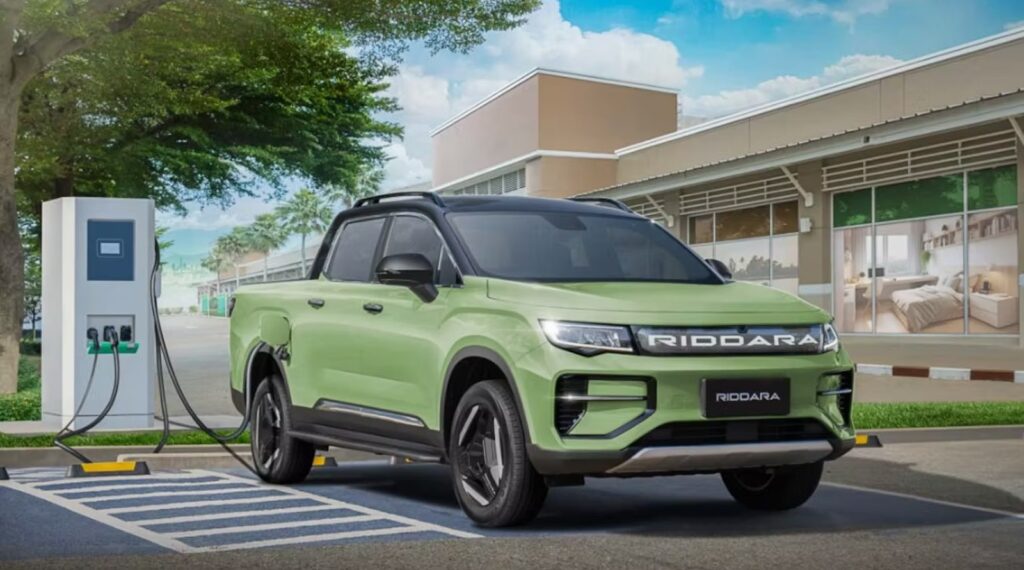
Sign up for daily news updates from CleanTechnica on email. Or follow us on Google News!
Geely Riddara recently held its 2025 GEELY RIDDARA Global Conference. Distributor representatives from over fifty countries gathered to review the achievements of last year and witness the launch of the 2025 Geely Riddara global strategy. Following the brand’s growth at home in China, where the brand extended its status as the #1 electric pickup brand in China from 2023 to 2025, the plan now is to push global expansion. According to Geely Riddara, the brand held over 50% of the Chinese market share for the last three consecutive years. Geely Riddara says the flagship model, the RD6, has a unique feature of “drive like an SUV, more than just a pickup.” The RD6 combines the comfort and performance of an electric SUV with the utility of a pickup truck, surpassing traditional pickups in power, intelligent technology, and multi-functionality. This makes the RD6 a key part of Geely Riddara’s global competitive edge.
Having held multiple launches in several regional markets, Geely Riddara already has a presence in over fifty countries and regions, including Eastern Europe, the Middle East, Asia-Pacific, Central America, and South America. Geely Riddara wants to step up things another notch in 2025. “In 2025, Geely Riddara will enter a new phase of global cooperation,” said Mr. Ling Shiquan, CEO of Geely Riddara. The brand will strengthen its presence in mature markets such as Thailand, Saudi Arabia, and Brazil, aiming for 30,000 units in global sales by 2025 and NEV (new energy vehicle) pickup market leadership in every region. South Africa is a key market for these kinds of pickups and the good news is Geely Riddara has partnered with Enviro Automotive to bring the Geely Riddara all-electric pickups to South Africa.
Both the 63 kWh rear-wheel drive and the 73 kWh all-wheel drive versions will be available in the South African market soon. The rear-wheel drive 63 kWh version has an LFP battery pack providing a range of 377 km (NEDC). It has a single, rear-mounted electric motor (max 200 kW and 384 Nm of torque). The all-wheel drive version has two variants, the “Pro” version with the 73 kWh battery pack (424 km NEDC range), then there is the “Ultra” version that gets an 86 kWh battery and provides a range of up to 455 km (NEDC). The dual-motor setup in the all-wheel drive models of the Geely Riddara RD6 provides 315 kW of power and 595 Nm of torque. All of this is good for a 0–100 km/h time of around 4.5 seconds according to the spec sheet. The RD6 has a frunk that can hold 70L. The main bed has a 1,200L capacity. Tow capacity is listed as 3,000 kg. The RD6 supports up to 11kW AC charging. It has multiple power outlets to support vehicle-to-load capability (6 kW), which is a cool feature that really should come standard in modern day EVs.
South Africans love pickups. Pickups are more commonly known as “bakkies” in South Africa. The Toyota Hilux (ICE) has traditionally been the top selling vehicle in South Africa. The Ford Ranger and the Isuzu D-Max are also popular. The introduction of the Riddara in South Africa would help increase the number of electric pickups available for consumers to buy, which would hopefully help grow sales of battery electric vehicles. There are probably people who generally love pickups and would not be considering getting an electric sedan or SUV but would be tempted to go for an all-electric pickup if the price is competitive with the equivalent popular ICE pickups.
The South African BEV market really needs a boost! 515,712 vehicles were sold in South Africa in 2024. Sales of battery electric vehicles (BEV) breached the 1,000 units per year mark in South Africa for the first time ever in 2024. Last year, 1,257 BEVs were sold in South Africa, up 35% from 929 units sold in 2023. That means BEVs only had a market share of 0.24%. That is still exceptionally low! With only 3,212 BEVs sold since 2018, it is clear to see that sales of BEVs have been slow in South Africa compared to similar auto markets around the world. Bringing EVs in the most popular categories, such as pickups, could really help to catalyse EV adoption.
There are some full BEV models available in the South African market, such as the first-generation 88kWh SAIC Maxus T90 EV. This one is priced at the higher end of the market. More options are needed to offer South African bakkie lovers a wider range to choose from. Another pickup from the SAIC stable is on its way to South Africa in the near future. JAC also has dealerships in South Africa and perhaps the JAC T9 BEV pickup could arrive in South Africa in the near future. That means there would be a couple of full BEV options in South Africa come the end of the year.
Perhaps a way to get fence sitters to switch to electric would be to entice them with plug-in hybrid pickups. PHEVs with electric ranges of 100–200 km would appeal to non-early adopters, especially in markets where charging infrastructure is not fully developed. Perhaps this is what some Chinese automakers are thinking, as quite a number of them are contributing to a new wave of new-generation PHEVs with battery packs of over 30 kWh and electric ranges of about 100 km, thereafter complemented by a 1.5T or 2.0T ICE engine. In China and some other markets, PHEVs are now cheaper to buy compared to equivalent full ICE vehicles — from both an upfront purchase perspective as well as an operating or total cost of ownership (TCO) perspective.
One such pickup that is coming to South Africa is the BYD Shark. The Dual Mode Offroad (DMO) BYD Shark pickup has an acceleration from 0 to 100 km/h of 5.7 seconds, and an NEDC range of 840 km from its 1.5T ICE engine paired with two electric motors. The front motor has a peak power of 170 kW and 310 Nm peak torque. The rear motor has a peak power of 150 kW and 340 Nm torque. The total from the electric powertrain is therefore 320 kW (429 hp) and 650 Nm peak torque! Energy is stored in the 29.58 kWh BYD Blade battery. All-electric range is stated as 100 km (NEDC). Another PHEV that will be launched soon in South Africa, although with a smaller battery and lower all-electric range, is the Ford Ranger PHEV.
Whether you have solar power or not, please complete our latest solar power survey.
Chip in a few dollars a month to help support independent cleantech coverage that helps to accelerate the cleantech revolution!
Have a tip for CleanTechnica? Want to advertise? Want to suggest a guest for our CleanTech Talk podcast? Contact us here.
Sign up for our daily newsletter for 15 new cleantech stories a day. Or sign up for our weekly one if daily is too frequent.
CleanTechnica uses affiliate links. See our policy here.
CleanTechnica’s Comment Policy

